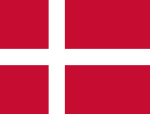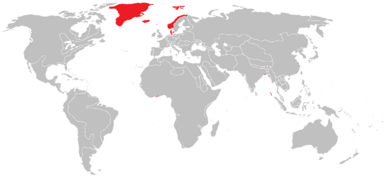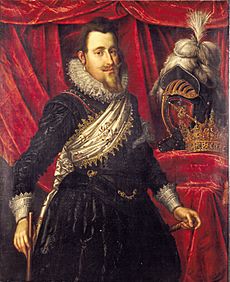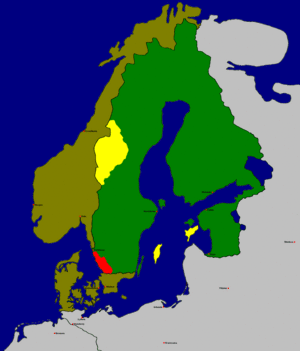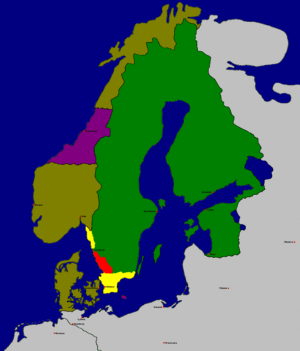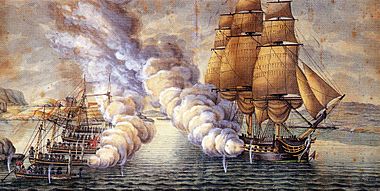Denmark–Norway facts for kids
Quick facts for kids
Denmark–Norway
Danmark–Norge
|
|||||||||||||||
|---|---|---|---|---|---|---|---|---|---|---|---|---|---|---|---|
| 1524–1533 1537–1814 |
|||||||||||||||
|
Motto: Fromhed styrker rigerne
("Piety strengthens the realms") Used from 1588–1648 |
|||||||||||||||
|
Anthem: Kong Christian stod ved højen mast
|
|||||||||||||||
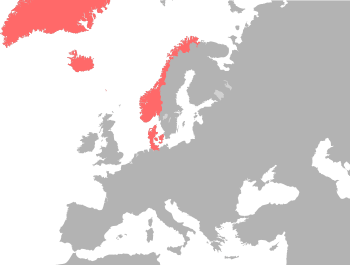
Map of Denmark–Norway, c. 1780
|
|||||||||||||||
| Status |
|
||||||||||||||
| Capital | Copenhagen (Denmark) Oslo (Norway) |
||||||||||||||
| Common languages | Official: Danish, German, Renaissance Latin Also spoken: Norwegian, Icelandic, Faroese, Sami languages, Greenlandic, North Frisian |
||||||||||||||
| Religion | 1524–1533 Catholic 1537–1814 Lutheran |
||||||||||||||
| Demonym(s) | Dano-Norwegian | ||||||||||||||
| Government | Monarchy
|
||||||||||||||
| King | |||||||||||||||
|
• 1524–1533
|
Frederick I | ||||||||||||||
|
• 1537–1559
|
Christian III (first) | ||||||||||||||
|
• 1588–1648
|
Christian IV (longest) | ||||||||||||||
| Legislature |
|
||||||||||||||
| Historical era | Early modern Europe | ||||||||||||||
6 June 1523 |
|||||||||||||||
|
• Kalmar Union collapsed
|
1537 | ||||||||||||||
|
• Norwegian riksråd
abolished |
1537 |
||||||||||||||
|
• Treaty of Brömsebro
|
13 August 1645 | ||||||||||||||
|
• Treaty of Roskilde
|
26 February 1658 | ||||||||||||||
|
• Danish rigsråd
abolished |
14 October 1660 |
||||||||||||||
14 November 1665 |
|||||||||||||||
| 14 January 1814 | |||||||||||||||
| September 1814 – June 1815 | |||||||||||||||
| Area | |||||||||||||||
| 1800 | 2,655,567 km2 (1,025,320 sq mi) | ||||||||||||||
| Population | |||||||||||||||
|
• 1645b
|
1,315,000 | ||||||||||||||
|
• 1801c
|
1,859,000 | ||||||||||||||
| Currency |
|
||||||||||||||
|
|||||||||||||||
| Today part of | |||||||||||||||
|
|||||||||||||||
Denmark–Norway was a powerful union of kingdoms that existed for many years in northern Europe. It included the Kingdom of Denmark and the Kingdom of Norway. At the time, Norway also controlled lands like the Faroe Islands, Iceland, and Greenland. The union also included parts of what is now Germany, like the Duchy of Schleswig and the Duchy of Holstein.
This large state was sometimes called the Dano-Norwegian Realm or the Oldenburg Monarchy. Its people were mainly Danes, Norwegians, and Germans. But it also had Faroese, Icelanders, and Inuit people. There was also a Sami minority in northern Norway.
The main cities were Copenhagen (in Denmark) and Christiania (now Oslo, in Norway). Danish and German were the main official languages. However, people also spoke Norwegian, Icelandic, Faroese, Sami, and Greenlandic.
The union began when Olaf II of Denmark became King of Norway in 1380. Later, Denmark, Norway, and Sweden formed the Kalmar Union in 1397. Sweden left this union in 1523. After that, Denmark and Norway became closely linked. From 1537, they formed a "personal union," meaning they shared the same king. This union lasted until 1814.
In 1814, the Treaty of Kiel said that Norway should join Sweden. But Norway didn't agree and fought back in the 1814 Swedish–Norwegian War. Norway then joined a looser union with Sweden until 1905, when both became fully independent countries.
Contents
Exploring the Denmark–Norway Union
The term "Denmark–Norway" shows the historical connection between the two countries. The kings always called themselves "King of Denmark and Norway." Even though they were united, Denmark and Norway had their own laws and money. They also had separate governments for a while.
After 1660, the government became more centralized in Copenhagen. This was partly because Sweden had tried to take over parts of Norway. Closer ties with Copenhagen helped Norway stay safe.
Overseas Colonies of Denmark–Norway
Throughout its history, Denmark–Norway controlled lands far away. In earlier times, these included areas in northern Europe and North America. For example, Estonia and the Norwegian lands of Greenland, the Faroe Islands, and Iceland.
From the 1600s, the union also gained colonies in Africa, the Caribbean, and India. At its largest, the empire covered about 2.6 million square kilometers (1 million square miles).
Colonies in India
Denmark–Norway had several colonies in India from the 1600s to the 1800s. These included the towns of Tranquebar and Serampore. The last of these settlements were sold to the United Kingdom in 1845. Rights in the Nicobar Islands were sold in 1869.
Caribbean Colonies
The Danish West Indies were located in the Virgin Islands. This colony was one of Denmark's longest-lasting. It was sold to the United States in 1917 and became the U.S. Virgin Islands.
West African Colonies
In the Gold Coast region of West Africa, Denmark–Norway controlled various colonies and forts. The last remaining forts were sold to the United Kingdom in 1850.
Key Moments in History
How the Union Began

Denmark, Norway, and Sweden first joined together in the Kalmar Union in 1397. Sweden left and rejoined several times. Finally, in 1521, Sweden left for good. This left Denmark and Norway (including their lands in the North Atlantic). Norway wanted to leave too in the 1530s. However, Denmark had a stronger military. In 1537, Denmark took over Norway and made it part of the lands ruled by the Oldenburg family. Norway kept its own laws and some institutions.
Northern Seven Years' War (1563–1570)
This war started because Denmark was unhappy that the Kalmar Union had broken up. The Danish-Norwegian king, Christian III, used the Swedish symbol of three crowns in his coat of arms. The Swedes saw this as Denmark claiming their land. In response, the Swedish king, Erik XIV of Sweden, added Norway's and Denmark's symbols to his own.
After some naval attacks by Denmark–Norway, the war began. It lasted seven years and ended with no major changes in territory for either side.
Kalmar War (1611–1613)
Denmark–Norway controlled trade in the Baltic Sea and North Sea. Sweden wanted to avoid paying tolls to Denmark. So, the Swedish king, Charles IX, tried to create a new trade route through northern Norway. He even started collecting taxes in Norwegian territory.
King Christian IV of Denmark–Norway protested. He didn't want a new trade route to open. He also wanted to force Sweden to rejoin the union. In 1611, Denmark–Norway invaded Sweden. The war ended with the Treaty of Knäred in 1613. Norway got back its land route from Sweden. Sweden also had to pay a large ransom for two fortresses. However, Sweden gained an important freedom from the Sound Toll.
The money from the ransom helped King Christian IV build new cities. These included Glückstadt, Christiania (Oslo), Christianshavn, Christianstad, and Christianssand. He also started the Danish East India Company, which led to Danish colonies in India.
Thirty Years' War (1618–1648)
Soon after the Kalmar War, Denmark–Norway joined a bigger war. They fought alongside Protestant states against Catholic states in Germany. Christian IV wanted to lead the Protestant states. However, Denmark suffered a big defeat at the Battle of Lutter in 1626. This caused many German Protestant states to stop supporting him. After another defeat, Denmark–Norway left the war in 1629.
Torstenson War (1643–1645)
Sweden did very well in the Thirty Years' War, but Denmark–Norway did not. Sweden saw a chance to gain more power. Denmark–Norway had territories that surrounded Sweden, which seemed like a threat. Also, the Sound Dues were still annoying to the Swedes. So, in 1643, Sweden decided to invade Denmark–Norway.
Denmark was not ready for the war, and Norway was slow to attack Sweden. This gave Sweden an advantage. The war ended with Sweden winning. In the Treaty of Brömsebro in 1645, Denmark–Norway had to give up some lands. These included Norwegian territories like Jemtland and Herjedalen. They also lost the Danish islands of Gotland and Ösel. This war helped Sweden become a great power. It also marked the start of a decline for Denmark–Norway.
Second Northern Wars (1657–1660)
The Dano-Swedish War (1657–1658) was very damaging for Denmark–Norway. After a huge loss, Denmark–Norway had to give Sweden a quarter of its land in the Treaty of Roskilde. This included the Norwegian regions of Trøndelag and Båhuslen. It also included all remaining Danish lands on the Swedish mainland and the island of Bornholm.
However, two years later, in 1660, the Treaty of Copenhagen was signed. This treaty gave Trøndelag and Bornholm back to Denmark–Norway.
Royal Absolute Monarchy
After Sweden finally left the Kalmar Union in 1521, there was a civil war and a religious change (the Protestant Reformation) in Denmark and Norway. Once things settled, the Danish Rigsraad (High Council) lost its power and was removed in 1660. The Norwegian Riksråd had already been removed in 1537.
In 1537, King Christian III made Norway a hereditary kingdom, closely linked with Denmark. Norway kept its own laws, a royal chancellor, separate money, and its own army. Denmark–Norway became an absolutist state. This meant the king had all the power and was only answerable to God. These changes were confirmed in the Leges regiae in 1665.
Scanian War (1675–1679)
Denmark had lost its lands in Scania (southern Sweden) after the Treaty of Roskilde. They wanted to get them back. But Sweden had become a great power, so it would be hard. However, Christian V saw a chance when Sweden was busy with another war. Denmark–Norway invaded Sweden in 1675.
The attack started well for Denmark–Norway. But the Swedes, led by 19-year-old Charles XI, fought back and took their land back. The war ended with no lasting gains or losses for either country.
Napoleonic Wars and the End of the Union
During the French Revolutionary Wars, Denmark–Norway tried to stay neutral. They wanted to trade with both France and the United Kingdom. But when they joined the Second League of Armed Neutrality, the British saw this as a hostile act. The British attacked Copenhagen in 1801 and again in 1807.
In the 1807 attack, the British captured the entire Dano-Norwegian navy. They burned most of the ships and took the rest for the Royal Navy. Denmark–Norway was not ready for a fight. Their army was gathered elsewhere, leaving the capital undefended. The British attack forced Denmark–Norway to become allies with the French. However, without a navy, they could do little.
Denmark–Norway was defeated. They had to give the Kingdom of Norway to the King of Sweden in the Treaty of Kiel. Denmark kept Norway's overseas lands like the Faroe Islands, Iceland, and Greenland. But the Norwegians did not accept this treaty. They declared Norway independent on May 17, 1814. They elected Crown Prince Christian Frederik as their king.
After a Swedish invasion, Norway had to accept a "personal union" with Sweden. This meant they shared a king. But Norway kept its own constitution and separate institutions. This union ended in 1905, when Norway became fully independent.
Life and Culture in the Union
Differences Between Denmark and Norway
After 1660, Denmark–Norway was made of four separate parts: Denmark, Norway, Schleswig, and Holstein. Norway had its own laws, some government bodies, its own money, and army. Denmark was more powerful culturally and politically.
Denmark was mostly a farming society. Norway, however, became more industrial from the 1500s. It had a strong economy based on exports like shipping, timber, and mining. This made Norway "the developed and industrialized part of Denmark-Norway."
Denmark and Norway traded a lot with each other. Norway needed Danish farm products. Denmark needed Norway's timber and metals. Norway was also a more equal society. In Norway, the king (the state) owned much of the land. In Denmark, large noble landowners were in charge. Danish farmers were often tied to the land they were born on. But all farmers in Norway were free. They could live anywhere and were generally richer than Danish farmers. Many Danes, like merchants and officials, saw Norway as a place with good opportunities. Norwegians also moved to Denmark, like the famous writer Ludvig Holberg.
Languages Spoken
Many languages were spoken across Denmark–Norway:
- Danish was the official and main language. It was used by most nobles and in churches in Denmark, Norway, Greenland, the Faroe Islands, and parts of Schleswig.
- High German was also official. It was used by some nobles and in churches in Holstein and parts of Schleswig.
- Low German was not official but was spoken in Holstein and parts of Schleswig. Some Hanseatic traders in Bergen also spoke it.
- Latin was often used in foreign relations. Some nobles also spoke it as a second language.
- Norwegian was not official but was the main spoken language in Norway.
- Icelandic was recognized as a church language in Iceland after the Reformation. It was spoken and written in Iceland.
- Faroese was not official but was spoken on the Faroe Islands.
- Sámi languages were not official but were spoken by Sami people in Norway.
- Greenlandic was not official but was spoken by Greenlandic Inuit.
- North Frisian was not official but was spoken in some parts of Schleswig.
Religion in the Union
Denmark–Norway followed Martin Luther after the Protestant Reformation. This made Lutheran Protestantism the official religion instead of Roman Catholicism. Lutheran Protestantism was the main religion for most of the union's history.
There was another religious change during the rule of Christian VI. He was a follower of Pietism. From 1735 to 1746, new laws were made to support Pietism. While Pietism didn't last long, smaller Pietistic movements appeared over the next 200 years.
Legacy of Denmark–Norway
After the union ended in 1814, some Norwegian writers in the 1800s called it a "400-year night." They said it was a dark period. However, historians now say this idea was a myth. It was used to argue against the later union with Sweden.
Since the late 1800s, people have looked at the Danish–Norwegian union more fairly. Historians have shown that Norway's economy actually grew during this time. Norway was one of the richest countries in the world during its union with Denmark.
Historians also point out that Norway was a separate state. It had its own army, laws, and other institutions. It had a lot of freedom in its own affairs. It was mostly run by Norwegian officials, even though they worked for the Danish King. Norwegians also held important positions in the military, government, and businesses of Denmark–Norway. They also helped manage the colonies. Norway benefited from the combined strength of Denmark–Norway in wars against Sweden. It also gained from trade with Denmark, where Norwegian industries had a special right to sell goods in Denmark. In return, Denmark supplied Norway with farm products.
See also
 In Spanish: Reino de Dinamarca y Noruega para niños
In Spanish: Reino de Dinamarca y Noruega para niños
- Kingdom of Norway (1814)
- Military history of Denmark
- Military history of Norway
- Possessions of Norway
- Union between Sweden and Norway
- Dano-Norwegian language


